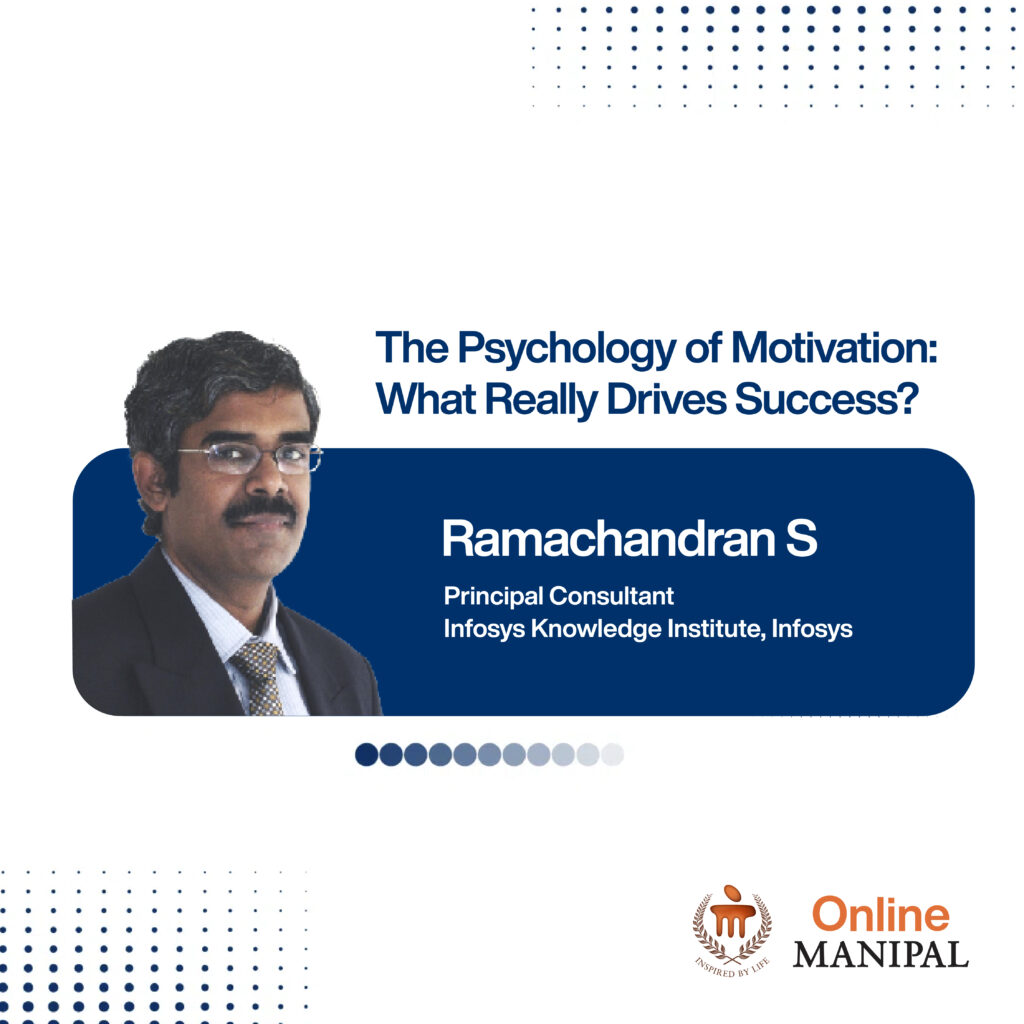Over my 25 years of experience and most recently in emerging technologies as a principal consultant at the Infosys Knowledge Institute, I’ve often wondered – what really drives success? How are some people able to push through challenges and some are not? The answer lies in motivation. But it may not be a one-size-fits-all concept. The aspects that motivate you may not be the same that motivates people around you. Think of it like a food buffet in life: different people like different dishes. What tastes great to you, may taste bland to others. To unlock full potential, you must understand the psychology of motivation and identify what ignites our inner fire.
Key theories of motivation
To understand the key concepts of motivation, we must first debunk some foundational theories that explain how it works:
1. Maslow’s hierarchy of needs: Abraham Maslow’s theory is visualized as a pyramid where each level represents a different human need. At the bottom of the pyramid are our physiological needs like food, water, shelter, and pay. Once these needs are met, we move up to safety needs like social security and job stability, followed by love and belonging, esteem, and finally, at the top-most lies, self-actualization. Maslow advised that we must satiate the lower-level physiological, safety, and belonging, before progressing to the higher ones represented in the pyramid.

Read more about: Maslow’s hierarchy of needs
2. Hertzberg’s two-factor theory of job-satisfaction: Frederick Herzberg, categorized job factors into hygiene or maintenance factors, and motivators.
- Hygiene factors: Salary and job security can prevent dissatisfaction but don’t essentially lead to motivation.
- Motivational factors: Such as job recognition or potential for promotion that truly drive employees to excel.
3. McClelland’s three needs theory: David McClelland theorized that three primary needs fuel an individual’s motivational needs: achievement, affiliation, and power.
- Achievement: The desire to excel and surpass what they had previously achieved.
- Affiliation: The need for acceptance into society.
- Power: The drive to influence, mentor, and lead others.
4. McKinsey study on motivation: A McKinsey article titled “What employees say matters most to motivate performance” provides further insights into employee motivation. The study, with over 1000 participants, emphasizes that performance management is most effective when it has a clear, consistent internal logic that employees understand. Goal setting is most impactful when goals are measurable and clearly linked to organisational priorities. Additionally, performance reviews conducted by skilled managers are vital, and investments in manager training to facilitate meaningful development discussions are beneficial.
You may find this interesting: The role of career guidance in helping students achieve their professional goals
Intrinsic vs. extrinsic motivation
Motivation is of two types: intrinsic and extrinsic. I’ve often seen professionals driven by extrinsic factors like job security and high pay. While these are indeed important, motivation, the kind that leads to self-actualization, often comes from within. It’s about feeling a sense of achievement, adding value to those around us, and realizing our full potential.
Productivity and performance fuelled by motivation
Motivation is the bedrock of productivity. When we’re motivated, we’re more focused, efficient, and involved. It’s a virtuous cycle: motivation fosters productivity, and achieving our goals further fuels our motivation.
You can also read more about Must have career objectives for freshers
KPIs and OKRs
The corporate world uses techniques like KPIs (Key Performance Indicators) and OKRs (Objectives and Key Results) to measure and enhance productivity.
- KPIs (Key Performance Indicators): KPIs are key metrics that are quantifiable and are used to measure performance of employees in a company.
- OKRs (Objectives and Key Results): These are a more comprehensive approach to driving teams toward objectives. OKRs provide a clear framework by specifying measurements required for each key result to achieve the overall objective.
Characteristics of OKRs
OKRs break down measurable outcomes into clearly defined and commonly understood concepts for strategic alignment.

OKRs vs. KPIs: Understanding the difference
| OKRs | KPIs |
| Strategy-focused, aggressive, time-bound (fixed duration) | Ongoing and performance-focused, measure the steady state |
| Focus on what needs to be achieved | Focus on how well metrics are achieved |
| Provides direction and alignment (the How) | Measures performance against pre-defined targets |
| Emphasis on ambitious, aspirational goals | Focus on achieving goals, incremental improvements |
What motivated me
On a personal note, writing my book Neoskilling for Digital Transformation with Professor L. Prasad was a major source of motivation for me. It’s a sense of accomplishment seeing others use and benefit from the frameworks I developed.
Neoskilling for digital transformation
In today’s evolving digital landscape, the concept of skilling has taken on new dimensions. It’s no longer just about acquiring a formal education or upskilling. Instead, we need to focus on ‘neoskilling’ or futuristic skill development, which is a crucial element in preparing for the skill sets needed in the future.
Neoskilling goes beyond traditional notions of skilling, upskilling, and reskilling. Whilst they signify basic education, improvement of acquired skills, and acquiring new skills to shift jobs or industries, neoskilling is a future-oriented approach focusing on preparing individuals for skill- sets that have not yet dominated the mainstream industry but will be critical in the future. For instance, quantum computing.
Disruptive innovation and career paths
In a discussion with Kellogg Professor, Mr. Mohanbir Sawhney, we discussed how artificial intelligence is disrupting traditional careers and jobs. This disruption isn’t just limited to AI, but digital technologies have had profound impacts across various industries.
For instance, a company that you may remember from older times – Kodak. Kodak was once an industry giant but soon went into bankruptcy and decline in business due to its failure to adapt to digital technology. This highlights the importance of neoskilling. Today’s career choices are no longer corporate, academic, and entrepreneurial branches, but an amalgamation of roles across these domains and new ones emerging.
Check out: How working professionals are upskilling their careers with Online Manipal
Finding the key to self-actualization
I really admire the concept of the Japanese concept of Ikigai, which is key to discovering our purpose of life. It’s the sweet spot where what you love, what you’re good at, what you can be paid for, and what the world needs intersect. In my opinion, finding your Ikigai is the definitive form of motivation. It’s where work becomes joyful, and you’re driven by a sense of purpose.

The final word
While chasing success, it’s essential to reflect on what truly matters in the long run.
Clayton Christensen wisely said,
The single most important factor in our long-term happiness is the relationships we have with our family and close friends. It is not the money you have earned and saved or your designation. It is the positive impact you have on people around you.
Ultimately, success isn’t just about career achievements—it’s about personal fulfilment and meaningful connections. Stay motivated, encourage lifelong learning, and make an impact!
Prepare for your next career milestone with us











